PUPPY GROOMING
Your puppy was groomed and desensitised to grooming tools, including electric clippers, while at Ridgy Didge, and it is important to continue this routine from Day 1 at home. See this great video of a family doing just that for their cobberdog pup!
The first 6 months
The puppy coat does not tangle, isn't smelly, and dirt falls out. BUT, you should still groom your pup right from homecoming!
Make grooming a normal part of your pup's routine, and your pup will grow to enjoy that down-time and pampering, and be patient and tolerant of the process. Grooming will be a mutually pleasant time spent together, instead of a constant struggle!
Brushing and grooming should be relaxed and not rushed; and can be very soothing and calming for your new puppy. It is a perfect activity to create and strengthen a wonderful bond between you and your pup, and it should be enjoyable for both of you. Make the grooming session short to begin with and finish before your puppy becomes distracted or needs to move.
Supervise children brushing the puppy, and teach them how to do it gently and effectively.
Around 6 months, the puppy’s coat will be longer and will start to knot and matt if you don’t brush it regularly. If you leave grooming till then, the puppy will not be used to the routine and everything will be so much harder! Matting and knots can trap dirt and moisture under the coat and this may cause skin irritation and possible infection issues.
9 Months of age
Your puppy’s coat will change around 9 months, into an adult coat. Remember that Cobberdogs are mostly low-shedding, so as the coat is changing, it can get VERY tangled with the adult coat growing through the baby fluff! At this time, it is really important to brush and comb daily until the tangles stop happening – around 6-8 weeks later.
After the adult coat is grown in, a good comb and brush every week will remove the growing out fibres and keep your dog’s coat looking and feeling wonderful!
How to Brush & Comb
Brush from under, and work up the coat in layers from bottom to top for best results. Comb after brushing, to finish and to find any matts you may have missed.
Any matting should be separated with the brush from underneath - lift the coat and start from below the tangle, clearing small sections at a time. After the matting is cleared, use a comb to ensure it is all matt-free.
To help detangle a coat that really needs help, we recommend Dr Show Mane’n’Tail Detangler & Shine. A little squeezed into the palm of your hand and then massaged through from the top to the tip of the coat using a raking action with your fingers spread. Starting combing the coat and you will find most tangles loosen immediately!
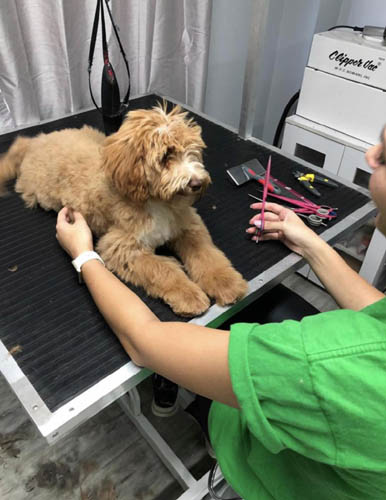
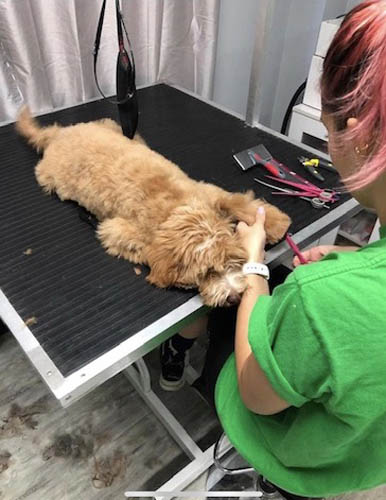
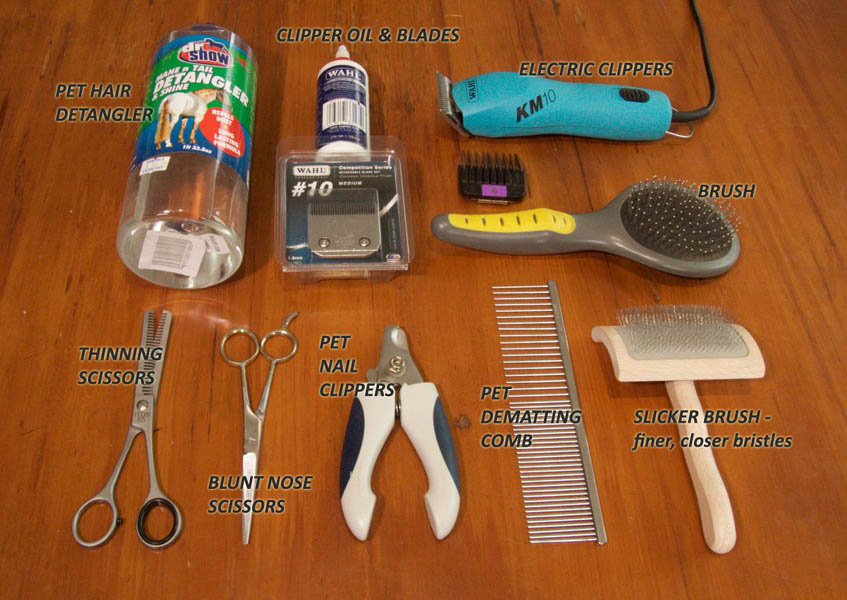
Your Grooming Toolkit
Professional dog groomers can do a wonderful job, however if you learn to groom and clip your dog yourself, you can save a lot of expense.
Your grooming tools don't have to be expensive, but a good pet grooming brush and comb are the basic essentials. Later add a slicker brush, thinning scissors, pet nail clippers, pet coat trimmer, and some detangling moisturiser for grooming your puppy as its coat and nails grow along with it!
Borrow the household hairdryer after bathing your dog, and your toolkit is complete.
BATHING & DRYING YOUR PUPPY
Most people bath their dogs to remove odour. However, Cobberdog coats are not naturally smelly or dirty coats as they don’t have an undercoat. What’s more, dirt just falls out of the coat like magic!
We recommend that you don’t bath your dog more than once a month, unless of course they have rolled in something really undesirable!
When you wash your puppy, we recommend you use organic wool wash and be very gentle. Never rub the coat, as this may cause matting; just gently massage the spirals and squeeze the soap through the coat.
Rinse off, wrap your pup in a towel and gently pat and squeeze the water away. Again, don’t rub!
Always have an adult dry your puppy with a hairdryer (on low and pointed along the coat away from the body and the face) unless it is a lovely sunny day and they can rest in a warm spot to dry naturally and fully. These coats take a long time to dry because there is so much coat, and you don’t want your puppy to catch a chill.
Once the coat is dry, brush with a slicker brush. The slicker brush has fine, close bristles, that really get the older fibres out.
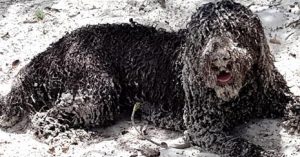
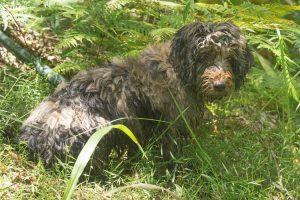
TO TRIM OR NOT TO TRIM?
Probably the better questions are: "Do you prefer your Cobberdog's coat long of short?" and "How much time will you dedicate to your Cobberdog's coat care?"
If you prefer your Cobberdogs coat long and flowing, don't trim except for the necessary special parts detailed below.
If you keep your adult Cobberdog's coat long you need to care for the coat to avoid matting; you must brush with the slicker brush and then comb through, the entire coat.
If a long coat is neglected and becomes truly matted, the coat may need to be professionally shaved.
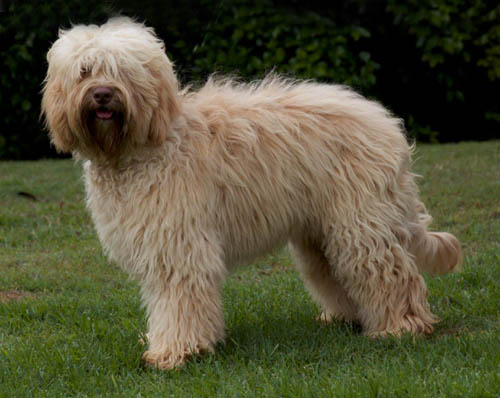
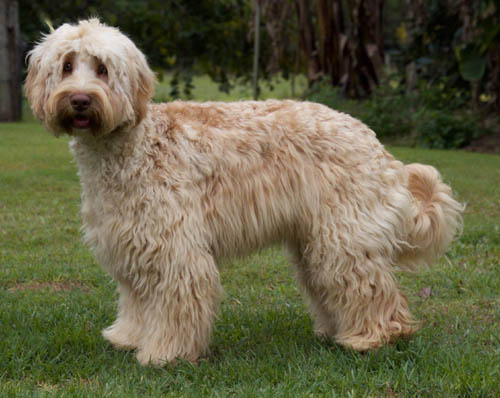
If you prefer your Cobberdog to look more lean and athletic, trimming the coat will achieve this. This short coat will require much less work, just a quick brush and comb once weekly will ensure it is kept in top condition.
Clipping done by a groomer can be up to $90 for a medium dog. To keep the clipped shape, this needs to be done 3 to 4 times per year. Clipping can be done can be done by owner using clippers (see the videos below), or even with scissors.
You may choose to keep the coat long in the cooler weather for extra warmth, and trim short for in the hotter months for quicker cooling and after-swim drying.
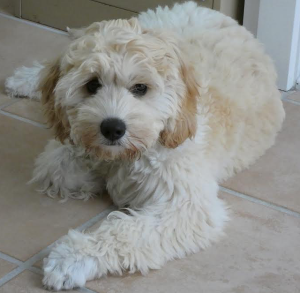
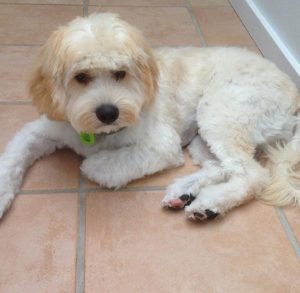
Trimming Special Areas
If you choose to keep your dog’s coat long, regular trimming of special areas is still important, for the following reasons.
- Trim around the eyes to keep vision clear.
- Trim around the chin for keeping this area clean while eating.
- Trim the hair between the footpads so puppy doesn’t slip on shiny surfaces, and to control grass seeds and other small items being trapped and causing issues.
- Trim where the collar sits to prevent rubbing and matting
- Trim around the ears to prevent matting where there is lots of movement; and trim the long fibres just inside the ears to help with ear hygeine.
- Trim around the anus to keep the dog clean when toileting.
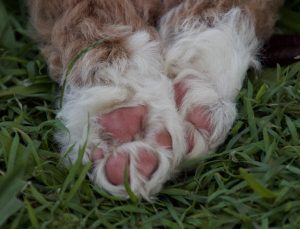
Safety Tips
Use blunt nosed safety scissors only.
Careful around the eyes - never point scissors towards the eyes.
Nails
When you puppy comes home, handle the feet often, between the paws and the nails, so they are used to their paws being handled. When they go home with you, they have already had this regular handling and desensitisation here at Ridgy Didge. Talk to your vet to check how to safely clip the tip of your dogs nails - they can advise you about the safe length and the type of clipper to use. Remember to check the Dew claw, higher up at the rear of the front paws, and keep trimmed as well.
Enjoy your well-groomed Cobberdog!
Watch a Cobberdog being trimmed
For great demonstrations on trimming the head and face, and the entire coat, here are 2 great videos by Tegans Cobberdogs.
Watch them both before you attempt any trimming! And watch again intermittently until you have become really good at clipping your dog!
